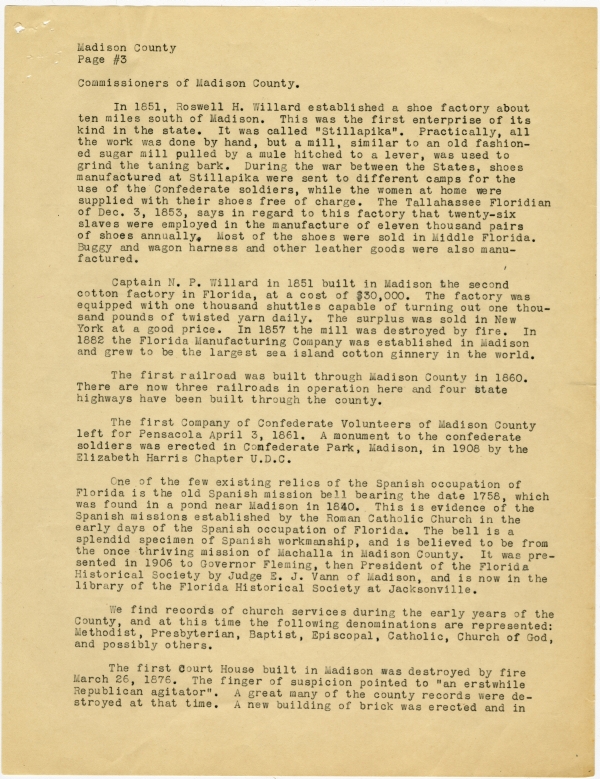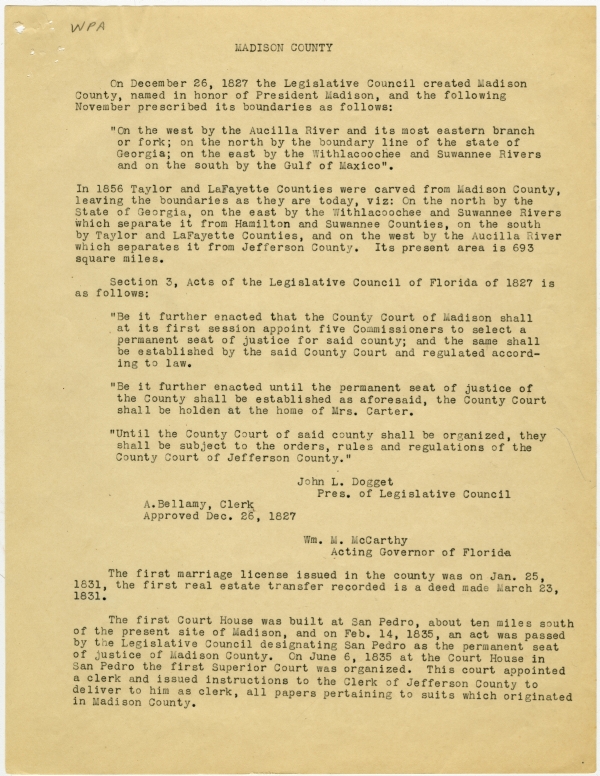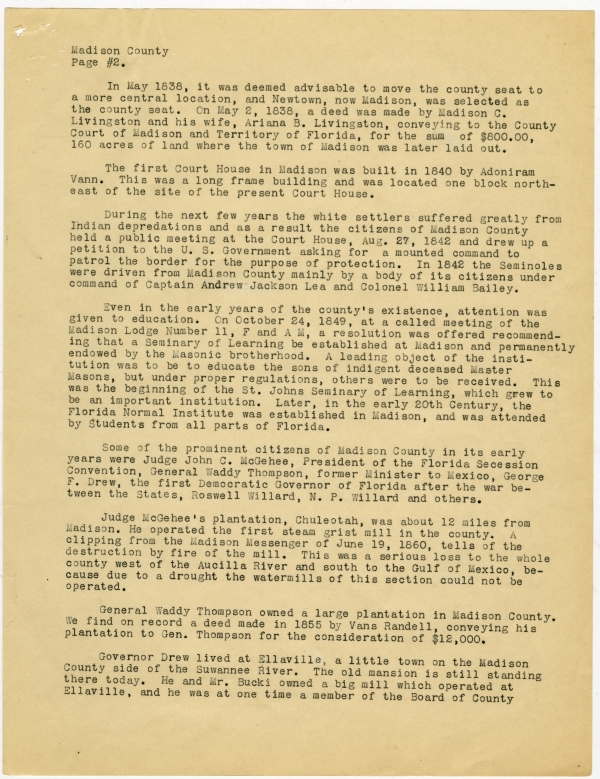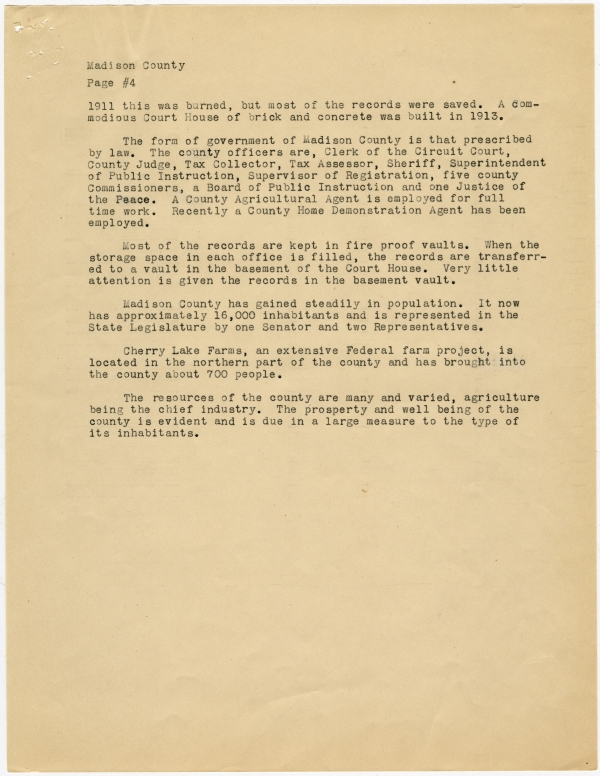WPA
MADISON COUNTY
On December 26, 1827 the Legislative Council created Madison County, named in honor of President Madison, and the following November prescribed its boundaries as follows:
"On the west by the Aucilla River and its most eastern branch or fork; on the north by the boundary line of the state of Georgia; on the east by the Withlacoochee and Suwannee Rivers and on the south by the Gulf of [Mexico]".
In 1856 Taylor and LaFayette Counties were carved from Madison County, leaving the boundaries as they are today, viz: On the north by the State of Georgia, on the east by the Withlacoochee and Suwannee Rivers which separate it from Hamilton and Suwannee Counties, on the south by Taylor and LaFayette Counties, and on the west by the Aucilla River which separates it from Jefferson County. Its present area is 693 square miles.
Section 3, Acts of the Legislative Council of Florida of 1827 is as follows:
"Be it further enacted that the County Court of Madison shall at its first session appoint five Commissioners to select a permanent seat of justice for said county; and the same shall be established by the said County Court and regulated according to law.
"Be it further enacted until the permanent seat of justice of the County shall be established as aforesaid, the County Court shall be holden at the home of Mrs. Carter.
"Until the County Court of said county shall be organized, they shall be subject to the orders, rules and regulations of the County Court of Jefferson County."
John L. Dogget
Pres. of Legislative Council
A. Bellamy, Clerk
Approved Dec. 26, 1827
Wm. M. McCarthy
Acting Governor of Florida
The first marriage license issued in the county was on Jan. 25, 1831, the first real estate transfer recorded is a deed made March 23, 1831.
The first Court House was built at San Pedro, about ten miles south of the present site of Madison, and on Feb. 14, 1835, an act was passed by the Legislative Council designating San Pedro as the permanent seat of justice of Madison County. On June 6, 1835 at the Court House in San Pedro the first Superior Court was organized. This court appointed a clerk and issued instructions to the Clerk of Jefferson County to deliver to him as clerk, all papers pertaining to suits which originated in Madison County.
Madison County
Page #2.
In May 1838, it was deemed advisable to move the county seat to a more central location, and Newtown, now Madison, was selected as the county seat. On May 2, 1838, a deed was made by Madison C. Livingston and his wife, Ariana B. Livingston, conveying to the County Court of Madison and Territory of Florida, for the sum of $800.00, 160 acres of land where the town of Madison was later laid out.
The first Court House in Madison was built in 1840 by Adoniram Vann. This was a long frame building and was located one block northeast of the site of the present Court House.
During the next few years the white settlers suffered greatly from Indian depredations and as a result the citizens of Madison County held a public meeting at the Court House, Aug. 27, 1842 and drew up a petition to the U. S. Government asking for a mounted command to patrol the border for the purpose of protection. In 1842 the Seminoles were driven from Madison County mainly by a body of its citizens under command of Captain Andrew Jackson Lea and Colonel William Bailey.
Even in the early years of the county's existence, attention was given to education. On October 24, 1849, at a called meeting of the Madison Lodge Number 11, F and A M, a resolution was offered recommending that a Seminary of Learning be established at Madison and permanently endowed by the Masonic brotherhood. A leading object of the institution was to be to educate the sons of indigent deceased Master Masons, but under proper regulations, others were to be received. This was the beginning of the St. Johns Seminary of Learning, which grew to be an important institution. Later, in the early 20th Century, the Florida Normal Institute was established in Madison, and was attended by Students from all parts of Florida.
Some of the prominent citizens of Madison County in its early years were Judge John C. McGehee, President of the Florida Secession Convention, General Waddy Thompson, former Minister to Mexico, George F. Drew, the first Democratic Governor of Florida after the war between the States, Roswell Willard, N. P. Willard and others.
Judge McGehee's plantation, Chuleotah, was about 12 miles from Madison. He operated the first steam grist mill in the county. A clipping from the Madison Messenger of June 19, 1860, tells of the destruction by fire of the mill. This was a serious loss to the whole county west of the Aucilla River and south to the Gulf of Mexico, because due to a drought the watermills of this section could not be operated.
General Waddy Thompson owned a large plantation in Madison County. We find on record a deed made in 1855 by Vans Randell, conveying his plantation to Gen. Thompson for the consideration of $12,000.
Governor Drew lived at Ellaville, a little town on the Madison County side of the Suwannee River. The old mansion is still standing there today. He and Mr. Bucki owned a big mill which operated at Ellaville, and he was at one time a member of the Board of County
Madison County
Page #3
Commissioners of Madison County.
In 1851, Roswell H. Willard established a shoe factory about ten miles south of Madison. This was the first enterprise of its kind in the state. It was called "Stillapika". Practically, all the work was done by hand, but a mill, similar to an old fashioned sugar mill pulled by a mule hitched to a lever, was used to grind the [tanning] bark. During the war between the States, shoes manufactured at Stillapika were sent to different camps for the use of the Confederate soldiers, while the women at home were supplied with their shoes free of charge. The Tallahassee Floridian of Dec. 3, 1853, says in regard to this factory that twenty-six slaves were employed in the manufacture of eleven thousand pairs of shoes annually. Most of the shoes were sold in Middle Florida. Buggy and wagon harness [sic] and other leather goods were also manufactured.
Captain N. P. Willard in 1851 built in Madison the second cotton factory in Florida, at a cost of $30,000. The factory was equipped with one thousand shuttles capable of turning out one thousand pounds of twisted yarn daily. The surplus was sold in New York at a good price. In 1857 the mill was destroyed by fire. In 1882 the Florida Manufacturing Company was established in Madison and grew to be the largest sea island cotton ginnery in the world.
The first railroad was built through Madison County in 1860. There are now three railroads in operation here and four state highways have been built through the county.
The first Company of Confederate Volunteers of Madison County left for Pensacola April 3, 1861. A monument to the confederate soldiers was erected in Confederate Park, Madison, in 1908 by the Elizabeth Harris Chapter U.D.C.
One of the few existing relics of the Spanish occupation of Florida is the old Spanish mission bell bearing the date 1758, which was found in a pond near Madison in 1840. This is evidence of the Spanish missions established by the Roman Catholic Church in the early days of the Spanish occupation of Florida. The bell is a splendid specimen of Spanish workmanship, and is believed to be from the once thriving mission of Machalla in Madison County. It was presented in 1906 to Governor Fleming, then President of the Florida Historical Society by Judge E. J. Vann of Madison, and is now in the library of the Florida Historical Society at Jacksonville.
We find records of church services during the early years of the County, and at this time the following denominations are represented: Methodist, Presbyterian, Baptist, Episcopal, Catholic, Church of God, and possibly others.
The first Court House built in Madison was destroyed by fire March 26, 1876. The finger of suspicion pointed to "an erstwhile Republican agitator". A great many of the county records were destroyed at that time. A new building of brick was erected and in
Madison County
Page #4
1911 this was burned, but most of the records were saved. A commodious Court House of brick and concrete was built in 1913.
The form of government of Madison County is that prescribed by law. The county officers are, Clerk of the Circuit Court, County Judge, Tax Collector, Tax Assessor, Sheriff, Superintendent of Public Instruction, Supervisor of Registration, five county Commissioners, a Board of Public Instruction and one Justice of the Peace. A County Agricultural Agent is employed for full time work. Recently a County Home Demonstration Agent has been employed.
Most of the records are kept in fire proof vaults. When the storage space in each office is filled, the records are transferred to a vault in the basement of the Court House. Very little attention is given the records in the basement vault.
Madison County has gained steadily in population. It now has approximately 16,000 inhabitants and is represented in the State Legislature by one Senator and two Representatives.
Cherry Lake Farms, an extensive Federal farm project, is located in the northern part of the county and has brought into the county about 700 people.
The resources of the county are many and varied, agriculture being the chief industry. The [prosperity] and well being of the county is evident and is due in a large measure to the type of its inhabitants.




 Listen: The Folk Program
Listen: The Folk Program

